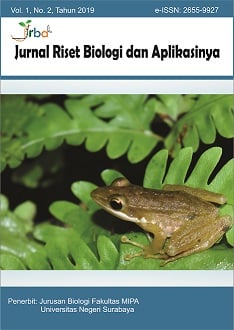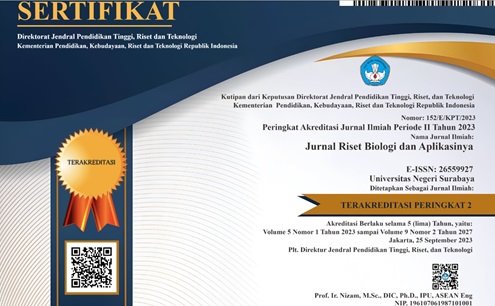Jenis-jenis Gulma Pada Kebun Tebu di Kecamatan Asembagus, Situbondo, Jawa Timur: Kelompok Eudikotiledon
DOI:
https://doi.org/10.26740/jrba.v1n2.p47-53Keywords:
Eudikotiledon, gulma, Situbondo, tebuAbstract
Agroekosistem perkebunan tebu tidak akan pernah lepas dari kehadiran gulma sebagaimana telah dipaparkan oleh Backer dalam Atlas of 220 weeds of sugarcane fields in Java pada tahun 1973. Hingga saat ini, informasi mengenai gulma-gulma di perkebunan tebu belum terhimpun secara utuh sedangkan kehadiran gulma-gulma terkini semakin banyak dilaporkan. Penelitian ini bertujuan untuk inventarisasi jenis-jenis gulma perkebunan tebu di lima desa yang terletak di Kecamatan Asembagus dilakukan menggunakan metode jelajah. Sebanyak 97 jenis gulma kebun tebu yang termasuk ke dalam 27 suku ditemukan di Kecamatan Asembagus. Sepuluh jenis di antaranya belum dicatat oleh Backer sebagai gulma pada kebun tebu.
References
Backer, C.A. (1934). Onkruidflora der Javasche Suikerrietgronden. Soerabaia: H. van Ingen.
Backer, C.A. & Bakhuizen van den Brink, R.C. (1963). Flora of Java. Vol. 1. Groningen: N.V.P. Noordhoff.
Backer, C.A. & Bakhuizen van den Brink, R.C. (1965). Flora of Java. Vol. 2. Groningen: N.V.P. Noordhoff.
Backer, C.A. (1973). Atlas of 220 Weeds of Sugarcane Fields in Java. Deventer: The Ysel Press.
Berg, C.C. & Corner, E.J.H. (2005). Moraceae: Ficeae. Flora Malesiana, Ser. I. 17(2), 1-70. Dikases dari https://borneoficus.info/wp-content/uploads/2018/06/Berg-Corner-2005-Flora-Malesiana-Moraceae-Ficus-.pdf.
BPS. (2017). Statistik Tebu Indonesia. http://www.bps.go.id/publication. Diakses tanggal 1 Juni 2019.
Chantaranothai, P. (2005). Taxonomic Notes on the genus Phyllanthus (Euphorbiaceae) in Thailand. Thai Forest Bulletin (Botany). 33, 16-20. Diakses dari: https://www.tci-thaijo.org/index.php/ThaiForestBulletin/article/view/24223.
Dell, M. & Olken, B.A. (2017). The Development Effects of the Extractive Colonial Economy: The Dutch Cultivation System in Java. The National Bureau of Economic Research Working Paper Series, 1-49. (DOI): 10.3386/w24009.
Hariri, M.R. & Irsyam, A.S.D. (2018). Catatan Tentang Solanum diphyllum L. (Solanaceae) Ternaturalisasi di Pulau Jawa. Al-Kauniyah Jurnal Biologi, 11(1), 25-32. Doi: http://dx.doi.org/10.15408/kauniyah.v11i1.5448.
Harlianingtyas, Hartati, D. & Salim, A. (2018). Modeling of rainfall and fertilization factor of sugarcane productivity in Asembagus sugar factory Situbondo. IOP Conf. Ser.: Earth Environ. Sci., 207, 012013. doi:10.1088/1755-1315/207/1/012013.
Irsyam, A.S.D. & Mountara, A. (2018). Plectranthus monostachyus (P Beauv.) B. J. Pollard (Lamiaceae) di Jawa. Floribunda, 6(1), 32-33. DOI: 10.32556/floribunda.v6i1.2018.223.
Knight, R. (2014). Sugar, Steam and Steel: The Industrial Project in Colonial Java, 1830-1885. Adelaide: The University of Adelaide.
Pysek, P. (1997). Compositae as invaders: Better than the others?. Preslia, 69(1), 9-22. Diakses dari https://www.researchgate.net/publication/281663404.
Raes, N., Saw, L.G., van Welzen, P.C. & Yahara, T. (2013). Legume diversity as indicator for botanical diversity on Sundaland, South East Asia. South African Journal of Botany. 89: 265-272. DOI: https://doi.org/10.1016/j.sajb.2013.06.004.
Richardson, D.M., Pyšek, P., Rejmánek, M., Barbour, M.G., Panetta, F.D. & West, C.J. (2000). Naturalization and invasion of alien plants: concepts and definitions. Diversity and Distributions, 6, 93-107.
Rugayah, Retnowati, A., Windadri, F.I. & Hidayat, A. (2004). Pengumpulan Data Taksonomi. Dalam Rugayah, E.A. Widjaja & Praptiwi (Eds). Pedoman Pengumpulan Data Keanekaragaman Flora (hlm. 5-42). Bogor: Puslit-LIPI. Doi: https://doi.org/10.1046/j.1472-4642.2000.00083.x
Soerjani, M., Kostermans, A.J.G.H. & Tjitrosoepomo, G. (1987). Weeds of Rice in Indonesia. Jakarta: Balai Pustaka.
Thaman, R.R. (1999). Wedelia trilobata: Daisy invader of the Pacific Islands (IAS Technical Report No. 99/2). Suva, Fiji Islands: University of the South Pacific.
Tjitrosoedirdjo, S. (2002). Notes on The Asteraceae of Sumatera. Biotropia. 19: 65-84. Diakses dari http://journal.biotrop.org/index.php/biotropia/article/view/230/199.
Tjitrosoedirdjo, S., Tjitrosoerdirdjo, S.S. & Setyawati, T. (2016a). Tumbuhan Invasif dan pendekatan Pengelolaannya. Bogor: Seameo Biotrop.
Tjitrosoedirdjo, S.S., Mawardi, I. & Tjitrosoerdirdjo, S. (2016b). 75 Important Invasive Plant Species in Indonesia. Bogor: Seameo Biotrop.
Tjitrosoerdirdjo, S.S. & Wahyuni, I. (2018). Rekor baru keberadaan Praxelis clematidea (Asteraceae) di Indonesia. Dalam D. Kurniadie, D. Widayat & U. Umiyati (Eds). Prosiding Seminar Nasional XX Himpunan Ilmu Gulma Indonesia: Resistensi Gulma Terhadap Herbisida dan Dampaknya terhadap Lingkungan dan Produk Pertanian (hlm. 212-217). Bogor: HIGI.
Downloads
Published
How to Cite
Issue
Section
 Abstract views: 11103
,
Abstract views: 11103
, PDF Downloads: 5444
PDF Downloads: 5444












